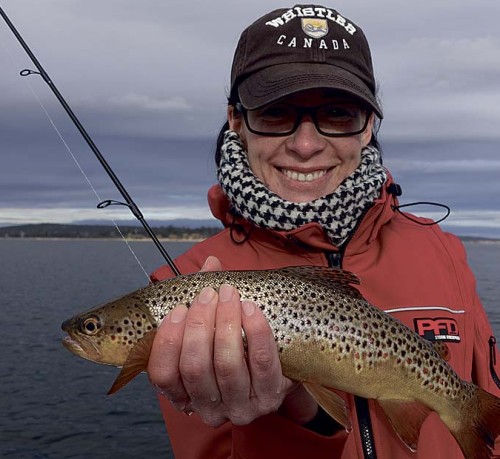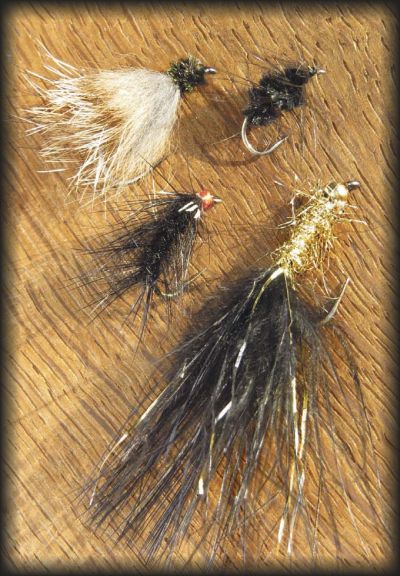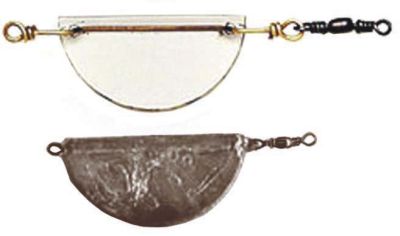From the Archives ...
Fishing on the Wild Side
Fishing on the Wild Side
Mike Fry doesn’t only live on the Wild Side of Tasmania, but also goes fishing in probably the wildest boat ever to troll for trout—certainly in Tasmania.
When your mate says ‘What are you doing tomorrow, want to come up the Gordon for the night?’ it would be pretty hard to say anything else except “you bet” and start checking out your tackle box and packing your overnight bag. But if your mate was Troy Grining and he wanted to give his new 52ft, high speed cruiser a run across Macquarie Harbour, test the new onboard dory with a chance of landing a nice Gordon River Brown you would have to feel privileged. I didn’t say anything about getting on my hands and knees and kissing his feet…just having a lend of ya’ but I did feel very appreciative.
 I said I would write about fly lines. I think it is Simon Gawesworth from RIO fly lines coloured string - and if you ever get the chance to listen to him, please do it. He is passionate about fly lines and helps explain them simply.
I said I would write about fly lines. I think it is Simon Gawesworth from RIO fly lines coloured string - and if you ever get the chance to listen to him, please do it. He is passionate about fly lines and helps explain them simply.
Realistically though fly lines are a hugely complex, so I will just give my very brief overview on floating trout lines.
Most fly lines sold are floating weight forward lines. There are a few double taper, spey, switch and sinking lines sold, but mostly they are floating WF. Lines are generally 90 feet, with a couple of lines used for tournament casters at 120 feet.
- Written by Stephen Smith - Rubicon Web and Technology Training
- Category: Tackle, Boats and other Equipment
- Hits: 4113
 |
| Free living Caddis larva Family Hydrobiosidae) |
The Peeping Stick Caddis
Presented from Issue 117, August 2015
Caddis larva are very high on trouts’ diet. They come in two forms, those that build portable homes (Stick Caddis) and free living. All caddis larva have a hardened section near and including the head, whilst the bodies are soft and range in colour from off white through to a dirty yellow and green in a variety of shades. They also have claws to cling onto the inside of their portable case. Caddis can be found in water from fast flowing streams to marshlands and lakes. Case building caddis use leaves, sticks, reeds or spun silk as a home. These are generally found in slow moving or still waters: others use sand or very small stones and these are normally found in streams.
- Written by Stephen Smith - Rubicon Web and Technology Training
- Category: Tackle, Boats and other Equipment
- Hits: 5115
 Presented from Issue 116, June 2015
Presented from Issue 116, June 2015
Pimping Colours
Winter is a great time for tackle tinkering… Reel maintenance, fly tying, replacing the rusty trebles on lures, or even pimping up your soft plastics for the coming season! As Starlo explains, customising the colours of your plastics isn’t hard. It’s also great fun, and can be highly effective!
In this occasional series of features, I want to look at the fascinating subject of customising soft plastic lures. In my opinion, this is an avenue of tackle tinkering that far too few anglers explore. Most buy their supplies of soft plastics from the tackle store and seem to assume that these versatile lures must be used in exactly the form they were packaged in by the manufacturer. In reality, nothing could be further from the truth!
Perhaps this notion that the maker knows best and that anglers shouldn’t “fiddle” with their products is a carry over from the world of hard-bodied luring. Beyond perhaps upgrading or replacing hooks and rings, very few anglers actively modify hard-bodied lures made from metal, plastic or timber. There are exceptions to this rule, of course. For example, some switched-on trout chasers have been adding bright, pea-sized red spots with lighter-coloured halos to their minnows, plugs and spoons for years, especially when fishing the pre-spawn and post-spawn runs of trout in autumn and spring. I first helped to popularize this custom colouration more than three decades ago, and gave it the name “spotted dog” in my writings. That label has stuck, and has even been picked up by some commercial lure makers. But I certainly can’t claim to have “invented” the actual spotted dog pattern. In fact, it was first shown to me by a very canny Finnish trout fisher named Erkki Norell in the early 1980s, and it had been used in his home country (with great success) for at least a generation or two prior to him telling me about it. There is very little under the sun that is truly “new”!
- Written by Stephen Smith - Rubicon Web and Technology Training
- Category: Tackle, Boats and other Equipment
- Hits: 3087
 Presented from Issue 115, April 2015
Presented from Issue 115, April 2015
While the action on the saltwater has been okay, the Tasmanian trout season has been far from great. Over the summer, I have fished many of the highland lakes, using both dry fly and micro-sized plastics. Although some of my trips have been productive, there have been many trips where I have put in long hours and plenty of effort, for only a few fish. It is with particular sadness, that Arthurs Lake - my favourite place to fish, has also let me down on a number of occasions. As with any fishing trip, I always endeavour to find a ‘silver lining’, and for me it has been that the few fish I have caught were noticeably larger, and in better condition, than the ones I caught the previous year.
- Written by Stephen Smith - Rubicon Web and Technology Training
- Category: Tackle, Boats and other Equipment
- Hits: 3290
Read more: Last cast - End of season soft plastic tips - Michal Rybka
 Presented from Issue 115, April 2015
Presented from Issue 115, April 2015
Lots of anglers seem to be deeply challenged when it comes to selecting that first soft plastic to tie on at a new location, or even to start a new day’s fishing at a well-known spot. In this feature I want to share with you some basic rules of thumb that will greatly ease the burden of this important decision making process:
Over the course of a year, I get to talk to a lot of soft plastics fishers from around the country. Some I meet at seminars and shows. Others I chat with via the various pages on Facebook that I run or help to administer (especially the StarloFishing and Squidgy Soft Plastics pages), or through my blogs on www.starlofishing.com Still others send their letters or emails to me via the various magazines I write for. However, no matter what the source of the enquiry, one question (or variations of it) dominates the calls for advice that I receive. Typically, that query begins with the words: “What’s the best soft plastic to use for…?”
- Written by Stephen Smith - Rubicon Web and Technology Training
- Category: Tackle, Boats and other Equipment
- Hits: 4073
Read more: Choosing the right soft plastic - Steve ‘Starlo’ Starling
 Presented from Issue 114, February 2015
Presented from Issue 114, February 2015
Crafting something with your own hands can be incredibly fulfilling. I have a trade background as a fitter, machinist and toolmaker and have made many things from metal, timber and other things over many years.
Some time ago I thought I would build a small drift boat and searched the internet for some plans. There are hundreds of plans online from free to a few hundred dollars. Like most things in life it is wise to spend enough to get what you need.
Drift boats are most common in the USA and used there mostly for floating downstream on rivers. The design is characterized by a wide, flat bottom, flared sides, a narrow, flat bow, and a pointed stern. A rocker is designed into the bottom along an arc from bow to stern of the boat. They are sort of back to front and can be rowed either way depending on the situation and speed of water. Drift boats have a very shallow draft and are very easily manoeuvred, spun around and held in fast water.
Drift boats have become more popular in recent times in Tasmania and we have many waters for which this style of boat is ideal. At least a three guides now use them and a few locals have either built or imported different styles.
Many pictures are at the end of the article.
- Written by Stephen Smith - Rubicon Web and Technology Training
- Category: Tackle, Boats and other Equipment
- Hits: 3848
Read more: I Built a Boat - ‘Suits a man and his dog or two good friends’ - Mike Stevens
 Can anyone help with any information regarding Tasy Cobra Wobblers, attached is a list I have so far with the blanks to fill in.
Can anyone help with any information regarding Tasy Cobra Wobblers, attached is a list I have so far with the blanks to fill in.
Cheers, Terry Radford This email address is being protected from spambots. You need JavaScript enabled to view it.
Please click here or on the image for a full size form
- Written by Stephen Smith - Rubicon Web and Technology Training
- Category: Tackle, Boats and other Equipment
- Hits: 3238
 Presented from Issue 111, August 2014
Presented from Issue 111, August 2014
By the end of the brown trout season I’m usually ready for a change, try to catch a tuna, stock up on some flathead or garfish. But by the first weekend in August I am refreshed and ready to go again. Early season is a great time of year in Tasmanian lakes, high water levels with cruising browns in shallow water, wet fly polaroiding, fishing with sinking lines to get to weed beds where the fish are holding and feeding, all great ways to catch an early season fish.
We all have our favourite flies and some great early season patterns. These are a few I like to fish early in the season.
- Written by Stephen Smith - Rubicon Web and Technology Training
- Category: Tackle, Boats and other Equipment
- Hits: 3755
Read more: Humungous jellybeans - how to use and tie them - Joe Riley
 Presented from Issue 111, August 2014
Presented from Issue 111, August 2014
Anti-kinks are a unique piece of inexpensive tackle. They can be very useful used correctly. By definition they are design to stop your line twisting and developing ‘kinks’ which are the result of line twist.
As a rule I tend to go by the KISS principal. Keep It Simple Stupid. That is to have as little clutter as possible on my line at all times. Line tied directly to the lure or snap and that’s it. But there are times when it is necessary to use an anti-kink.
There are several different types, mostly plastic for want of a better word, although there are weighted lead, aluminium and brass version floating around but these tend to be older styles. All are designed to act as a keel and track straight through the water. All are shaped like a semi-circle or half-moon probably the best description.
- Written by Stephen Smith - Rubicon Web and Technology Training
- Category: Tackle, Boats and other Equipment
- Hits: 8351
![]() Presented from Issue 111, August 2014
Presented from Issue 111, August 2014
If you’re anything like me, your tackle box is overflowing with various trout lures that you have hardly used. I insist on keeping them however, just in case ‘the right time’ happens. However, realistically it is pretty much the same six lures that get tied on every trout season, simply because I have the most confidence in them. This confidence has come from years of these lures constantly producing good results; it is not easy for a lure to make the cut at being one of the six. There are so many good trout lures on the market today, lures that grab your eye as soon as you walk along the lure wall, however these six lures don’t just catch fisherman, they catch trout.
- Written by Stephen Smith - Rubicon Web and Technology Training
- Category: Tackle, Boats and other Equipment
- Hits: 32847
Current TFBN
Click above for current issue content. The current issue of TFBN is extensive and topical. In Tackle Stores, Newsagents and by subscription.
Delivered to your door for $48 for 2 years (8 issues). To subscribe, send Mike $48 via www.paypal.com.au . (Basic instructions are here) The email is at Contact Us. Your address will be included from PayPal.
Or phone Mike with your c/c handy on 0418129949
Please ensure your details are correct, for Mike to organise delivery.
TFBN Newsletter Sign up Form
Why not submit an article ?
When you have finished for the day, why not have a brag about the ones that didn't get away! Send Mike an article on your fishing (Click here for contact details), and we'll get it published here. Have fun fishing - tasfish.com
Category Descriptions
Here is a list of all of the Article Categories. The number in Brackets, eg (13) is the number of articles. Click on Derwent River and all articles relating to the Derwent will be displayed in the central area.
Articles by Category
-
Rivers (3)
-
Saltwater and Estuary Fishing (149)
-
Kayak Fishing (34)
-
Lakes (1)
-
Great Lake (62)
-
Lake Leake (52)
-
Woods Lake (16)
-
Lake Augusta (11)
-
Huntsman Lake (13)
-
Lake Pedder and Gordon (10)
-
Lake Dulverton (5)
-
Lake Crescent (6)
-
Tooms Lake (10)
-
Lake Mackintosh (2)
-
Lake Barrington (5)
-
Little Lake (8)
-
Meadowbank Lake (5)
-
Lake King William (7)
-
Lake St Clair (2)
-
Western Lakes (12)
-
Arthurs Lake (35)
-
Lake Echo (7)
-
Four Springs (54)
-
Lake Sorell (7)
-
Lake Burbury (6)
-
Other Lakes (57)
-
Brushy Lagoon (18)
-
Little Pine Lagoon (5)
-
Penstock Lagoon (16)
-
Brumbys Creek (7)
-
-
Events (48)
-
Estuary Fishing (0)
-
Coastal Catches (46)
-
Super Trawler (46)
-
IFS, DPIPWE, MAST and Peak Bodies (435)
-
Commercial Interests (98)
-
Other (24)
-
TFBN Back Issues (8)
-
Fly Fishing (67)
-
Trout Fishing (250)
-
Meteorology and Weather (8)
-
Jan’s Flies (50)
-
Tuna Fishing and other Game Fishing (86)
-
Cooking Fish (19)
-
Fishing Information (1)
-
Fishing Books (8)
-
Videos (5)
-
Tackle, Boats and other Equipment (146)
-
World Fly Fishing Championship 2019 (2)
Popular Tags
windyty.com
Visit https://www.windyty.com/
Rubicon Web and Technology Training
Hello everyone, I thought it would be a good time to introduce myself.
My name is Stephen Smith and I have been managing the website tasfish.com since May 2009.
It has been an epic journey of learning and discovery and I am indebted to Mike Stevens for his help, support and patience.
I am developing a new venture Rubicon Web and Technology Training ( www.rwtt.com.au ). The focus is two part, to develop websites for individuals and small business and to train people to effectively use technology in their everyday lives.
Please contact me via www.rwtt.com.au/contact-me/ for further information - Stephen Smith.
From the Archives ... (last chance)
Trout tips - from tackle shops
Presented from Issue 105, August 2013
We did a bit of a runaround Tasmania’s tackle stores to see what their tips for the first month or so of the tackle season were. We asked what the top three places to fish were, plus lures, flies, baits and a few other things.
Here is a rundown on their answers Whenever, and wherever you fish - anywhere, or for any fish in the world - ask the locals and especially ask at the local tackle store. They know what was caught today, yesterday and on what.



